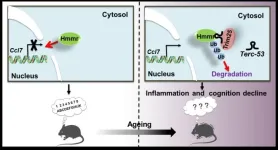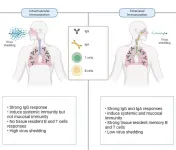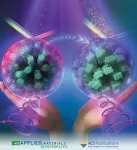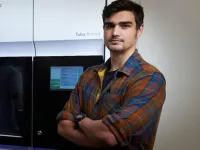Noncoding RNA Terc-53 and hyaluronan receptor Hmmr regulate aging in mice
2024-08-27
(Press-News.org)
The authors investigate the physiological functions of Terc-53 by creating transgenic mice that overexpress this noncoding RNA. They observe that Terc-53 overexpression affects normal aging in mammals, contributing to cognitive decline and shortened lifespan. Mechanistically, they find that Terc-53 binds to and promotes the degradation of Hmmr, leading to enhanced inflammation in tissues and accelerated aging. They also note that Hmmr levels decrease with age in certain brain regions, similar to Terc-53's pattern, and that restoring Hmmr levels can improve cognitive abilities and reduce neuroinflammation markers.
Key findings from the study include:
Terc-53's Role in Aging: Terc-53 overexpression in mice leads to age-related cognitive decline and a shorter lifespan, indicating its involvement in normal mammalian aging processes.
Hmmr as Effector of Terc-53: Hmmr is identified as a target of Terc-53, with Terc-53 mediating its degradation. This degradation increases inflammation, contributing to accelerated aging.
Restoration of Hmmr Improves Cognition: Supplementing Hmmr in the hippocampus of aging Terc-53 transgenic mice reverses cognitive decline, suggesting a potential therapeutic strategy for age-related cognitive issues.
Tissue-Specific Aging Patterns of Hmmr: Hmmr's involvement in aging appears to be tissue-specific, with varying expression patterns across different organs.
The study highlights the complexity of aging in mammals and the significance of noncoding RNAs and proteins that emerged late in evolution. It demonstrates that Terc-53 regulates organismal aging through the stability of Hmmr and the modulation of neuroinflammation. The findings open new avenues for understanding and potentially treating age-related physical debilities and improving healthspan. By identifying Hmmr as a critical mediator of Terc-53's effects on aging, the research suggests that strategies aimed at stabilizing Hmmr could mitigate age-related cognitive decline and inflammation. The work entitled “ Noncoding RNA Terc-53 and hyaluronan receptor Hmmr regulate aging in mice” was published on Protein & Cell (published on May. 09, 2024).
END
[Attachments] See images for this press release:

ELSE PRESS RELEASES FROM THIS DATE:
2024-08-27
A next-generation COVID-19 mucosal vaccine is set to be a gamechanger not only when delivering the vaccine itself, but also for people who are needle-phobic.
New Griffith University research, published in Nature Communications, has been testing the efficacy of delivering a COVID-19 vaccine via the nasal passages.
Professor Suresh Mahalingam from Griffith’s Institute for Biomedicine and Glycomics has been working on this research for the past four years.
“This is a live attenuated intranasal vaccine, called CDO-7N-1, designed ...
2024-08-27
A research group led by Nagoya University has developed an innovative approach to creating anti-counterfeiting labels for high-value goods. Their findings, published in ACS Applied Materials & Interfaces, enhance the security of the currently used cholesteric liquid crystals (CLCs) by adding fluorescent dyes to produce florescent CLCs (FCLCs).
Using this unique technology, the group created unique labels with almost impossible-to-counterfeit security features. These advanced labels are designed to protect valuable items, important documents, and sensitive products ...
2024-08-27
The Beckman Institute for Advanced Science and Technology funded two research projects in 2024 as part of its research seed grant program. The program supports interdisciplinary research projects and is now in its second year.
This year, two research projects beginning in May 2024 received $75,000 per year for up to two years.
Research projects seeded by the Beckman Institute anticipate growth and typically lead to external funding proposals after the two-year seeding term.
Exploring how ASD-related genes influence brain networks that guide behavior
The CDC estimates that “1 in 36 children has been identified with autism spectrum disorder,” or ASD.
ASDs ...
2024-08-27
A team of researchers led by Rutgers University-New Brunswick scientists has analyzed crop yields of more than 1,500 fields on six continents, and found that production worldwide of important, nutritionally dense foods such as fruits, vegetables, nuts and legumes is being limited by a lack of pollinators.
The results, detailed in Nature Ecology & Evolution, showed that across diverse crops and locations, one-third to two-thirds of farms contain fields that aren’t producing at the levels they should be due to a lack of pollinators. The phenomenon of a low crop yield because of insufficient visits by insects is known as pollinator limitation.
The ...
2024-08-27
The American Meteorological Society is proud to announce its 2025 Awards and Honors, recognizing outstanding contributions to the weather, water, and climate community. 2025 recipients will be honored at the 105th AMS Annual Meeting in New Orleans, 12–16 January, 2025.
“One of our key priorities at AMS is to recognize the work of our global weather, water, and climate enterprise for the impact they have on scientific advancement and public safety, as well as on economic growth for all communities,” says Awards Oversight Committee Chair ...
2024-08-27
BOZEMAN – Scientists at Montana State University have been studying unique immune systems for decades, and a research team in the Department of Microbiology and Cell Biology took another step forward with work described in a paper published in the highly regarded journal Nature.
The Aug. 7 paper, titled “A virally-encoded tRNA neutralizes the PARIS antiviral defense system,” was fast-tracked for publication by the journal due to the importance of the findings. MSU doctoral student ...
2024-08-26
The National Institutes of Health (NIH) and the higher education non-profit VentureWell have selected 11 winners and five honorable mentions in the Design by Biomedical Undergraduate Teams (DEBUT) Challenge, who are set to receive prizes totaling $160,000. The awards will be presented to the winning teams on Oct. 25, 2024, during the annual Biomedical Engineering Society conference in Baltimore.
Now in its 13th year, the annual DEBUT Challenge calls on teams of undergraduate students to identify ...
2024-08-26
Three distinct problems in data science — trend identification in graphs, the quantitative study of scientific literature and evaluation of single-cell genomics — will all be addressed by new research in large-scale network analytics, jointly led by Distinguished Professor David Bader at New Jersey Institute of Technology.
The problems have a common challenge of finding patterns, known as community detection, from inside incredibly large datasets. Work is funded by a $648,000 National Science Foundation grant, Cyber-Infrastructure ...
2024-08-26
Researchers from the California NanoSystems Institute at UCLA and their colleagues have received a one-year, $1 million grant as part of a new National Science Foundation program aimed at accelerating the development and commercialization of quantum technologies for the benefit of society.
The Quantum Sensing and Imaging Lab, or Q-SAIL, which will be led by UCLA quantum physicist David Leibrandt, is one of five pilot projects across the country selected by the NSF to participate in the agency’s new National Quantum Virtual Laboratory, a first-of-its-kind national resource to enable the faster ...
2024-08-26
SAN FRANCISCO—Viruses are tricky to keep up with. They evolve quickly and regularly develop new proteins that help them infect their hosts.
These rapid shifts mean that researchers are still trying to understand a multitude of viral proteins and precisely how they increase viruses’ infecting abilities—knowledge that could be crucial for developing new or better virus-fighting treatments.
Now, a team of scientists at Gladstone Institutes and the Innovative Genomics Institute led by Jennifer Doudna, PhD, have harnessed computational tools to predict the three-dimensional shapes of nearly 70,000 viral ...
LAST 30 PRESS RELEASES:
[Press-News.org] Noncoding RNA Terc-53 and hyaluronan receptor Hmmr regulate aging in mice






